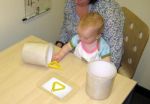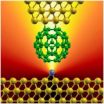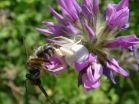(Press-News.org) How do you get a preschooler to help with chores and other household tasks? A new study suggests that adults' word choice can make a big difference.
The study, by researchers at the University of California, San Diego, the University of Washington, and Stanford University, appears in the journal Child Development.
The researchers carried out two experiments with about one hundred and fifty 3- to 6-year-olds from a variety of ethnic and racial backgrounds who came from middle- to upper-middle-class homes. In both experiments, an adult experimenter began by talking to children about helping. The only difference between the two studies was that in one, helping was referred to with a verb (e.g., "Some children choose to help"), while in the other, it was referred to with a noun (e.g., "Some children choose to be helpers"). Then the children began playing with toys. While they were playing, the adult provided four opportunities for the youngsters to stop and help the experimenter—to pick up a mess, open a container, put away toys, and pick up crayons that had spilled on the floor. In each case, the children had to stop playing to help.
The researchers also gathered baseline data, looking at to what extent a child chose to help the experimenter when helping was never mentioned.
Children who heard the noun wording (helper) helped significantly more than children who heard the verb wording (help). When the experimenter talked to youngsters about helping, using verb wording, the children didn't help any more than when the experimenter never brought up helping at all.
"These findings suggest that parents and teachers can encourage young children to be more helpful by using nouns like helper instead of verbs like helping when making a request of a child," says Christopher J. Bryan, assistant professor of psychology at the University of California, San Diego, who worked on the study. "Using the noun helper may send a signal that helping implies something positive about one's identity, which may in turn motivate children to help more."
INFORMATION:
Summarized from Child Development, "Helping" Versus "Being a Helper": Invoking the Self to Increase Helping in Young Children, by Bryan, CJ (University of California, San Diego), Master, A (University of Washington), and Walton, GM (Stanford University). Copyright 2014 The Society for Research in Child Development, Inc. All rights reserved.
Want a young child to 'help' or 'be a helper'? Choice of words matters
2014-04-30
ELSE PRESS RELEASES FROM THIS DATE:
Working memory differs by parents' education; effects persist into adolescence
2014-04-30
Working memory—the ability to hold information in your mind, think about it, and use it to guide behavior—develops through childhood and adolescence, and is key for successful performance at school and work. Previous research with young children has documented socioeconomic disparities in performance on tasks of working memory. Now a new longitudinal study has found that differences in working memory that exist at age 10 persist through the end of adolescence. The study also found that parents' education—one common measure of socioeconomic status—is related to children's ...
Magnitude of quake scales with maturity of fault, suggests new study by German scientist
2014-04-30
SAN FRANCISCO -- The oldest sections of transform faults, such as the North Anatolian Fault Zone (NAFZ) and the San Andreas Fault, produce the largest earthquakes, putting important limits on the potential seismic hazard for less mature parts of fault zones, according to a new study to be presented today at the Seismological Society of America (SSA) 2014 Annual Meeting in Anchorage, Alaska. The finding suggests that maximum earthquake magnitude scales with the maturity of the fault.
Identifying the likely maximum magnitude for the NAFZ is critical for seismic hazard ...
Out of sight but not out of mind: Babies transfer learning from pictures to real objects by 9 months
2014-04-30
Babies begin to learn about the connection between pictures and real-life objects early on. A new study has found that by 9 months, babies can learn about an object from a picture of it and can transfer that learning to the real object when they come across it.
The study, by researchers at Royal Holloway, University of London and the University of South Carolina, appears in Child Development, the journal of the Society for Research in Child Development.
"The study should interest any parent or caregiver who has ever read a picture book with an infant," says Jeanne L. ...
Babies recognize real-life objects from pictures as early as 9 months
2014-04-30
Babies begin to learn about the connection between pictures and real objects by the time they are nine-months-old, according to a new study by scientists at Royal Holloway, University of London, and the University of South Carolina.
The research, published today in Child Development, found that babies can learn about a toy from a photograph of it well before their first birthday.
"The study should interest any parent or caregiver who has ever read a picture book with an infant," said Dr Jeanne Shinskey, from the Department of Psychology at Royal Holloway. "For parents ...
New health system scorecard shows little progress among states from 2007-2012
2014-04-30
New York, NY, April 30, 2014—States made little progress in improving health care access, quality, and outcomes and lowering costs in the five years preceding implementation of the major coverage provisions of the Affordable Care Act (2007-2012), according to the Commonwealth Fund's third state health system scorecard. The majority of states declined or failed to improve on two-thirds of the 34 scorecard indicators that could be tracked over time.
Wide gaps among states persisted since the last scorecard, with top states sometimes performing two to eight times better ...
Direct current, another option to improve the electrical power transmission
2014-04-30
Electricity is normally transmitted by means of alternating current, but it is not the only way and not always the best one.In some cases, high voltage direct current (HVDC) is used. In Spain, for example, there is only one direct current line, the one that connects mainland Spain with the Balearic Islands; all the remaining ones transmit electricity by means of alternating current.
In fact, "direct current continues to be highly suitable for underwater and underground lines," asserted Marene Larruskain, one of the engineers in the UPV/EHU's GISEL group. Furthermore "less ...
A small connection with big implications: Wiring up carbon-based electronics
2014-04-30
Carbon-based nanostructures such as nanotubes, graphene sheets, and nanoribbons are unique building blocks showing versatile nanomechanical and nanoelectronic properties. These materials which are ordered in the nanoscale, that is, in the dimension of a millionth of millimetre, are promising candidates to envision applications in nanoscale devices, ranging from energy conversion to nano-electronic transistors. A good connection between carbon-based materials and external metallic leads is of major importance in nanodevice performance, an aspect where an important step has ...
Like puzzle pieces, 3-D genomics holds a key to classifying human diseases
2014-04-30
To solve a puzzle, you need to recognize shapes, patterns and a particular kind of order. In much the same way, researchers at McGill University have discovered that the 3D shape of a leukemia cell's genome holds a key to solving the puzzle of human diseases. The researchers report their findings in the open access journal Genome Biology.
McGill professor Josée Dostie, a researcher in the Faculty of Medicine in the department of Biochemistry, focused on the shape made by the region spanning the Homeobox A (HOXA) genes in human cells -- a set of 11 genes encoding proteins ...
Safe(bee) in numbers
2014-04-30
Bumblebees can distinguish between safe and dangerous environments, and are attracted to land on flowers popular with other bees when exposed to perilous situations, according to new research from Queen Mary University of London.
The study published in the journal Proceedings of the Royal Society B, shows that past experience of predation causes bumblebees to join other bees already safely feeding on flowers.
Co-author and PhD student Erika Dawson said: "Our experiment shows for the first time that when bees find themselves in these predator-infested environments ...
Molecular networks provide insights for computer security, Carnegie Mellon finds
2014-04-30
PITTSBURGH—The robust defenses that yeast cells have evolved to protect themselves from environmental threats hold lessons that can be used to design computer networks and analyze how secure they are, say computer scientists at Carnegie Mellon University.
Environmental "noise" is a key evolutionary pressure that shapes the interconnections within cells, as well as those of neural networks and bacterial/ecological networks, they observe in a paper to be published online April 30 by the Journal of the Royal Society Interface. The researchers factored this into an established ...



